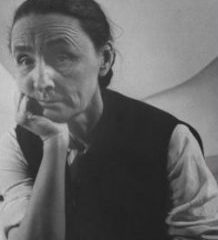Dorothea Lange (1895 - 1965)

Dorothea Lange was born in Hoboken, New Jersey on May 26, 1895, the first child of German-American parents, Joan and Henry Nutzhorn. Unfortunately, at age 7 she contracted the dreaded disease poliomyelitis, which left her right leg crippled. She suffered ridicule from classmates and even her own mother was ashamed of her. For unknown reasons, her successful lawyer father abandoned the family and was never heard from again when Dorothea was 12 years old. Given these circumstances and those times, one would expect this child to shrivel up and live a spinster life but not Dorothea. With no income, Joan and her two children moved to New York to live with her mother and aunt and took a job as a librarian. Dorothea went to school near her mother’s job and this gave her the opportunity to explore Manhattan via long walks to and from school. Possibly, by trying not to focus on her own inhibitions, she paid keen attention to her surroundings especially the people in their varying walks of life from the homeless to women hanging laundry. From this she developed visual acuity and a strong will to succeed. Dorothea was not the academic type but knew that she wanted to be a photographer so when she left school at age 18 she asked a famous photographer, Arnold Genthe if she could intern with him. He gave her the opportunity and the rest is history. In her professional life, Dorothea took her mother’s maiden name, Lange, moved to San Francisco, opened her own portrait studio on Sutter Street, and became a famous photographer like her mentor. This newfound success (circa early 1920’s) brought her friends and a social life resulting in her first marriage to artist Maynard Dixon, a man 20 years her senior. This union produced two children (Daniel in 1925 and John in 1928) and lasted for over 15 years. With the stock market crash of 1929 and the resulting depression, there were little need for portrait artists and this catastrophic event again forced her on the streets to call upon her knowledge of people and their sufferings. This time her probing camera captured the hungry in bread lines to the despair of those who lost their fortunes and became beggars. As luck would have it, Dorothea’s work landed in the hands of Paul Schuster Taylor, an economist, working for California’s State Economic Relief Administration (SERA). His job was to document the distress of poor migrant workers working and living conditions. Although his reports were well documented, he felt that Dorothea Lange, through her captive lens, could further depict the plight of his subjects. Their collaboration over the years was greeted with much success as the government allocated funds (for the first time ever) for migrant workers housing, social, educational, and recreational life. The couple fell in love, divorced their respective spouses, and married in 1935. Over the years, Dorothea traveled the country and abroad (Vietnam, Egypt, Ireland, and Latin America) to capture images that reflected the predicament of the New Deal Relief efforts such as the Deep South’s out-of-work sharecroppers, Oklahoma’s dustbowl emigrants, labor strikes, and shipyard workers but her most famous works was connected to the bombing of Pearl Harbor by the Japanese and the subsequent Executive Order 9066 by President Franklin Roosevelt to take all Japanese people (110,000) living the U.S. (both naturalized and those born here) to the interior and held in prison camps. Dorothea was angered by the suffering endured by these innocent Japanese families and was one of the chosen few allowed to photograph the Japanese’s round-up, evacuation, and assembly into the camps. Later in her life, Dorothea was again struck with another debilitating disease in addition to post-polio syndrome. This time it was cancer of the esophagus but again it did not stop her from breaking new ground. She was invited by MOMA to participate in the first “one man” retrospective exhibit by a woman and she accepted the challenge despite her battle with cancer. She and Paul stayed together until her death on October 11, 1965 at age 70. Please see one of Dorothea works attached, which is an image of the Japanese prison camp.
Featured Artist: Georgia O'Keeffe

Georgia Totto O’Keeffe (11/15/1887-03/06/1986) is an American icon known mostly for her paintings depicting flowers (some say erotic), shells, rocks, landscapes especially of Mexican desert and animal bones. According to Fichner-Rathus (1992) O’Keeffe works on flowers are “frequently reminiscent of parts of the female body…in their implied sexuality, and so they seem symbolically to express a feminist polemic ” (p. 423). In Sun Prairie, Wisconsin where she was born to dairy farmer parents Francis Calyxtus O’Keeffe and Ida Totto O’Keeffe, Georgia (named after her maternal grand dad George) was the second of seven children. As a young girl, her parents moved to Virginia but left Georgia behind in the care of her aunt. She later joined her family in Williamsburg. Georgia enrolled in the Art Institute of Chicago, the Art Students League, and the University of Virginia before going to Teachers College, Columbia University in New York. During this period, she studied under the tutelage of Alon Bement Dow who encouraged her to change her style from realism to abstraction, which resulted in her much acclaimed early abstract works. In 1918, Georgia met her future husband, photographer Alfred Stieglitz who was much older than her. He showed her work in Whitney Museum without her permission. When she confronted him he told her that he could make her famous because her works were so unique and large. They fell in love and he left his wife Emmeline and lived with Georgia for six years until he got his divorce from Emmeline and they got married. Alas, it is reputed that Alfred was openly unfaithful to their marriage. This forced her into recluse and she suffered a mental breakdown. In the late 1920’s Georgia visited to New Mexico and fell in love with the place but did not settle there permanently until 1949 three years after the death of her husband. In the early 1960’s Georgia met a potter named Juan Hamilton who became her constant companion. They taught each other their individual craft. An illustrious title attributed to Georgia is the ‘Mother of American Modernism’ for her bold abstracts. Sayre (1997), on describing O’Keeffe’s 1935 Purple Hills Near Abiquiu stated that she hones a “sensuous line…to create a landscape that almost seems to be alive, a body capable of moving and breathing… (p. 473). In her later years, Georgia suffered from macular degeneration and poor eyesight, forcing her to hire apprentices to paint what she described from her recollection and vivid imagery. On her death at age 98, her will disclosed that Juan was the successor to her vast estate but her family contested the codicils made to her will adding Juan. In the end, her assets were transferred to the Georgia O’Keeffe Museum in Sante Fe to commemorate Georgia’s life works.

Georgia O'Keeffe: Series One White and Blue Flower Shapes, 1919. Fichner-Rathus, L. (1992). Understanding art. Englewood Cliffs, NJ: Simon and Schuster. Georgia O'Keeffe. (2015). In Wikipedia. Retrieved from https://en.wikipedia.org/wiki/ Georgia_O%27Keeffe Georgia O'Keeffe Museum. (2015). About Georgia O'Keeffe. Retrieved from http://www.okeeffemuseum.org/about-georgia-okeeffe/ Heller, N. G. (1987). Women artists: An illustrated history. New York, NY: Cross River Press. Sayre, H. M. (1997). A world of art (2nd ed.). Upper Saddle River, NJ: Prentice Hall. Zelanski, P., & Fisher, M. P. (2011). The art of seeing. Upper Saddle River, NJ: Pearson Education, Inc. Wowherart.com Editor
Susannah Abbey @ http://myhero.com/myhero/hero.asp?hero=d_lange
http://www.dorothea-lange.org/Resources/AboutLange.htm http://en.wikipedia.org/wiki/Dorothea_Lange
